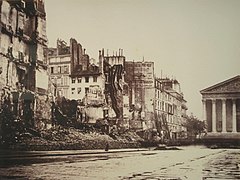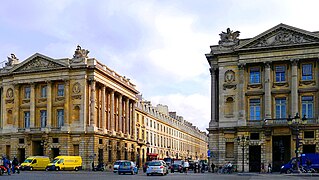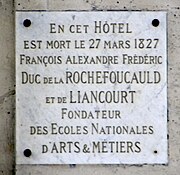Rue Royale
| Rue Royale | |
|---|---|
| location | |
| quarter | 8th. |
| Beginning | 2, Place de la Concorde |
| The End | 2, Place de la Madeleine |
| morphology | |
| length | 282 m |
| width | 22.80 and 43 m |
| history | |
| Emergence | from 1758 |
| designation | March 11, 1768 |
| Original names | hemin des Remparts Rue Royale-des-Tuileries (1757) Rue de la Révolution (1792) Rue de la Concorde (1795) Rue Royale-Saint-Honoré (1814) Rue Royale (1830) |
| Coding | |
| Paris | 8375 |
Rue Royale is the name of a street between Place de la Concorde and Place de la Madeleine in the 8th arrondissement of Paris .
location
The 282 meter long and 22 meter wide Rue Royale is located in the Rive Droite of Paris in the Quartier de la Madeleine of the 8th district and has a single intersection through which the Rue Royale, the Rue Saint-Honoré from the Rue du Faubourg Saint-Honoré separates . From the Place de la Concorde , Rue Royale offers a view of La Madeleine .
The street can be reached by metro via the following stations:
Metro lines 8 and 12 run under the street.
Name origin
The name comes from the fact that the street was laid out as a driveway to "Place Louis XV " (today Place de la Concorde ).
Rue Royale around 1900, photographer unknown, Library of Congress
history
The street replaced the Porte Saint-Honoré , which stood on the corner of Rue Saint-Honoré , built under Louis XIII. and demolished in 1733 together with the city walls to the Jardin des Tuileries . By decree of June 21, 1737, the king also ordered “que les façades des constructions à élever dans la nouvelle rue seraient établies d'après une architecture uniforms”. As the Plan de Turgot from 1736 shows, the construction of the Rue Royale did not require a breakthrough and no special rounding of the site, because the Rue de la Bonne Merue was still located there in 1754.
The city administration granted the road building permit for the Rue Royale on April 22nd, 1732 after the completion of the Place de la Concorde in 1776, it was supposed to connect this square with the church La Madeleine in a northerly direction. Work on the church was interrupted in December 1791 due to the French Revolution , but this did not prevent the road from continuing. After completion, it received on March 11, 1768 in honor of the reigning King Louis XV. first the name Rue Royale. During the Revolution it was called Rue de la Révolution from July 1792, then briefly Rue Royale Saint-Honoré. From 1795 it was called Rue de la Concorde, since April 27, 1814 it has been called Rue Royale again.
Rue Royale after the fighting and fires of the Commune (May 1871), photographer unknown
Bruno Braquehais , Paris. Rue Royale. Prize de vue depuis les marches de la Madeleine , National Library of Brazil .
Attractions
The building was built by Étienne-Louis Boullée (No. 3) or Louis Le Tellier (No. 6, 8, 9, 11, 13). Some have received the original decoration (nos. 6, 7, 8, 11, 13).
- Nos. 1 and 2: The monumental buildings of the Hôtel de Crillon and the Ministry of the Navy that belong to the Place de la Concorde protrude into the south side of the Rue Royale .
- No. 3: The former Hôtel Richelieu , where the famous Maxim’s restaurant has been located since April 1893 (with Belle Epoque decor and ambience ), the house has belonged to Pierre Cardin since 1981 .
- No. 5: Former address of the Molyneux fashion boutique , founded in 1919. Today Pierre Cardin runs a perfumery here.
- No. 9: The headquarters of the luxury cutlery manufacturer Christofle since 1992
- No. 11: A hotel has stood here since 1781, and today the Lalique luxury goods trade has been based there since 1935 , as is the porcelain shop of the Bernardaud brand, founded in 1863 .
- No. 16: Seat of the Ladurée bakery founded in 1862 . In 1871, when Baron Haussmann gave Paris a makeover, a fire enabled the bakery to be converted into a pastry shop. Ernest Ladurée came up with the idea of mixing the genres: Parisian coffee and pastries. This is how one of the first Salon de thé ( German : tea room) in the capital was created. - This building is a listed building and has kept the same equipment since it was rebuilt after the fire. Ladurée is a pastry shop famous for its macaroons.
- No. 20: The photographer Eugène Druet opened an art gallery here in 1908.
- No. 21: Villeroy & Boch has a branch here.
- No. 22: Count Pacquier dies here in 1862 .
Where the Rue Royale flows into the Place de la Concorde ; Hotel de Crillon on the left, Hotel de la Marine on the right
No. 6, facade of the Georges Fouquet jewelry shop , designed in 1901 by Mucha , Paris , Musée Carnavalet
Commemorative plaque Count de La Rochefoucauld-Liancourt at No. 9
Movie
René Clément shot the film Le Château de verre ( German Rendezvous in Paris ) based on Vicki Baum's novel “The multiplication table” here in 1950 .
literature
- Jean-Marie Pérouse de Montclos (ed.), Le Guide du patrimoine. Paris , Paris, Hachette , 1994.
- Félix de Rochegude, Promenades dans toutes les rues de Paris. VIIIe arrondissement , Paris, Hachette, 1910.
Individual evidence
- ^ Rochegude , p. 77
- ↑ German that the facades of the buildings to be erected on the new street may have a uniform architectural design
- ↑ Etienne Teisserenc, Geographie Parisienne en forme de dictionnaire , 1754, p. 48
- ^ Rochegude , p. 78
Coordinates: 48 ° 52 ' N , 2 ° 19' E













